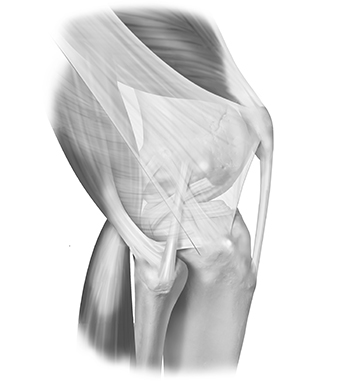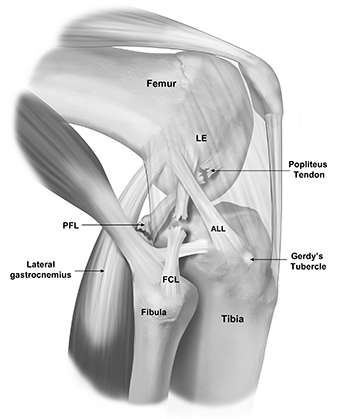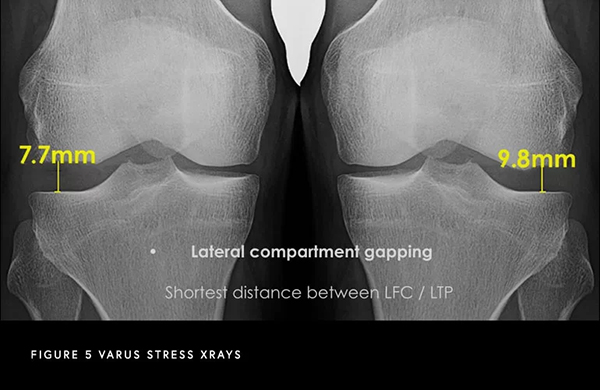LCL Injuries
What is the lateral collateral ligament (LCL)?
The lateral (fibular) collateral ligament (LCL or FCL) is a structure that stabilizes the lateral (outside) side of the knee connecting the thigh bone to the fibula (smaller of the two lower leg bones that sits on the outside). It prevents forces applied to the inner side of the knee from gapping open on the outside (varus stress).
The posterolateral corner of the knee, once known as “the dark side of the knee” because doctors did not have a clear understanding of the anatomy and biomechanics, is now a well-recognized cause of knee disability and dysfunction. There are three primary structures that comprise the posterolateral corner of the knee: the LCL, the popliteus tendon, and the popliteofibular ligament. All these structures work together to stabilize the outside of the knee. The LCL is like a tight rope that prevents your knee from gapping open on the outside of the knee. The popliteus tendon and the popliteofibular ligament prevent the tibia (shinbone) from externally rotating (outwards) on the femur (thigh bone).

PLC injuries can occur in several ways including contact (i.e. hit/blow to the inside of your leg, car accident, pivoting injury) or noncontact injuries (falling on a hyperextended knee). These injuries allow the outside of the knee to gap open (varus gapping), as well as the increased external (outside) rotation of the lower leg (tibia).
Sometimes, the nerve that is very close to all these structures (the common peroneal nerve) can be affected. This is a highly debilitating injury that needs to be assessed as soon as possible by an experienced surgeon. This injury can sometimes lead to a foot drop (you cannot lift your foot/toes up towards the ceiling) because the nerve is damaged. Sometimes, the nerve can be decompressed restoring full function. Sometimes it is permanently damaged, and a tendon transfer (transferring a tendon from another part of the knee) can be done to help with the foot drop in order to make walking easier.

- Pain: Pain on the outer side of the knee is a common symptom of a torn LCL. The pain may range from mild to severe, depending on the extent of the injury.
- Swelling
- Stiffness: The knee may become stiff, making it difficult to fully bend or straighten the leg.
- Instability: An individual with a torn LCL may feel that the knee is unstable, as if it’s “giving way” or unable to support their weight properly, especially when shifting side-to-side.
- Movement: Difficulty stopping and cutting towards the affected side.
- Bruising: Bruising can develop around the site of the LCL tear, and the discoloration is often seen on the outer side of the knee.
- Difficulty Walking: Walking may be uncomfortable or painful, particularly if the LCL tear is severe or involving the entire PLC.
- Popping or Clicking Sensation: Some people report a popping or clicking sensation when the injury occurs, which may be followed by pain and swelling.
A combination of a comprehensive physical examination, special x-rays, and an MRI are usually very accurate. Dr. Jorge Chahla and his team will perform a physical exam that will include testing your knee in an extended (straight) and flexed position to determine the location and severity of the injury. A special x-ray, called a varus stress x-ray, will likely be obtained. This special x-ray allows Dr. Chahla to objectively quantify and diagnose (based on validated systems) a posteromedial corner injury with millimeter accuracy. An MRI will allow Dr. Chahla to further evaluate the extent of the LCL injury as well as to evaluate the knee for any concomitant ligament, meniscal, or cartilage injuries.

The lateral collateral ligament (LCL) plays a crucial role in stabilizing the outer side of the knee. Injuries to the LCL can occur from direct impact, excessive twisting, or sudden changes in direction, leading to pain, swelling, and instability. Dr. Jorge Chahla, a leading orthopedic knee surgeon, specializes in diagnosing and treating LCL injuries, offering expert care to restore knee stability and function. If you have sustained an LCL injury, schedule a consultation at Dr. Chahla’s office in Chicago, Naperville, or Oak Brook to discuss the best treatment options for your recovery.
At a Glance
Dr. Jorge Chahla
- Triple fellowship-trained sports medicine surgeon
- Performs over 800 surgeries per year
- Associate professor of orthopedic surgery at Rush University
- Learn more



